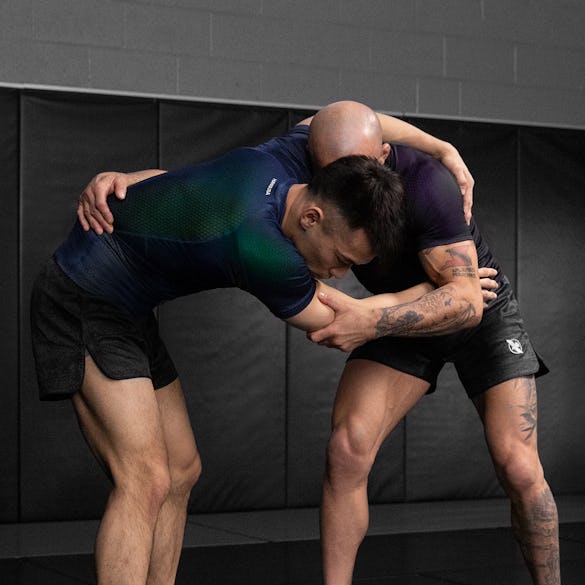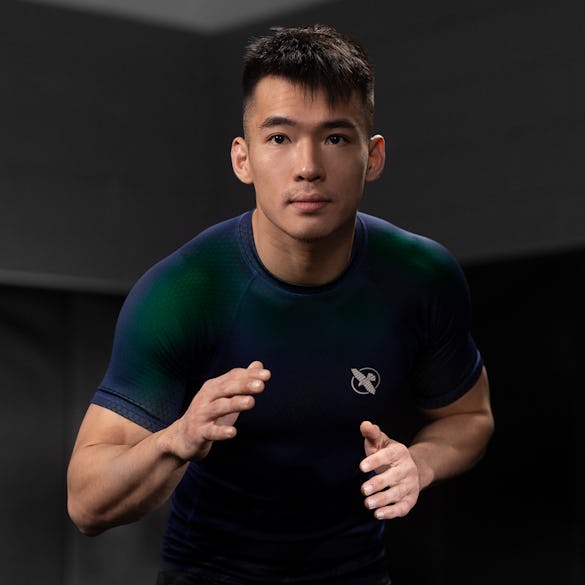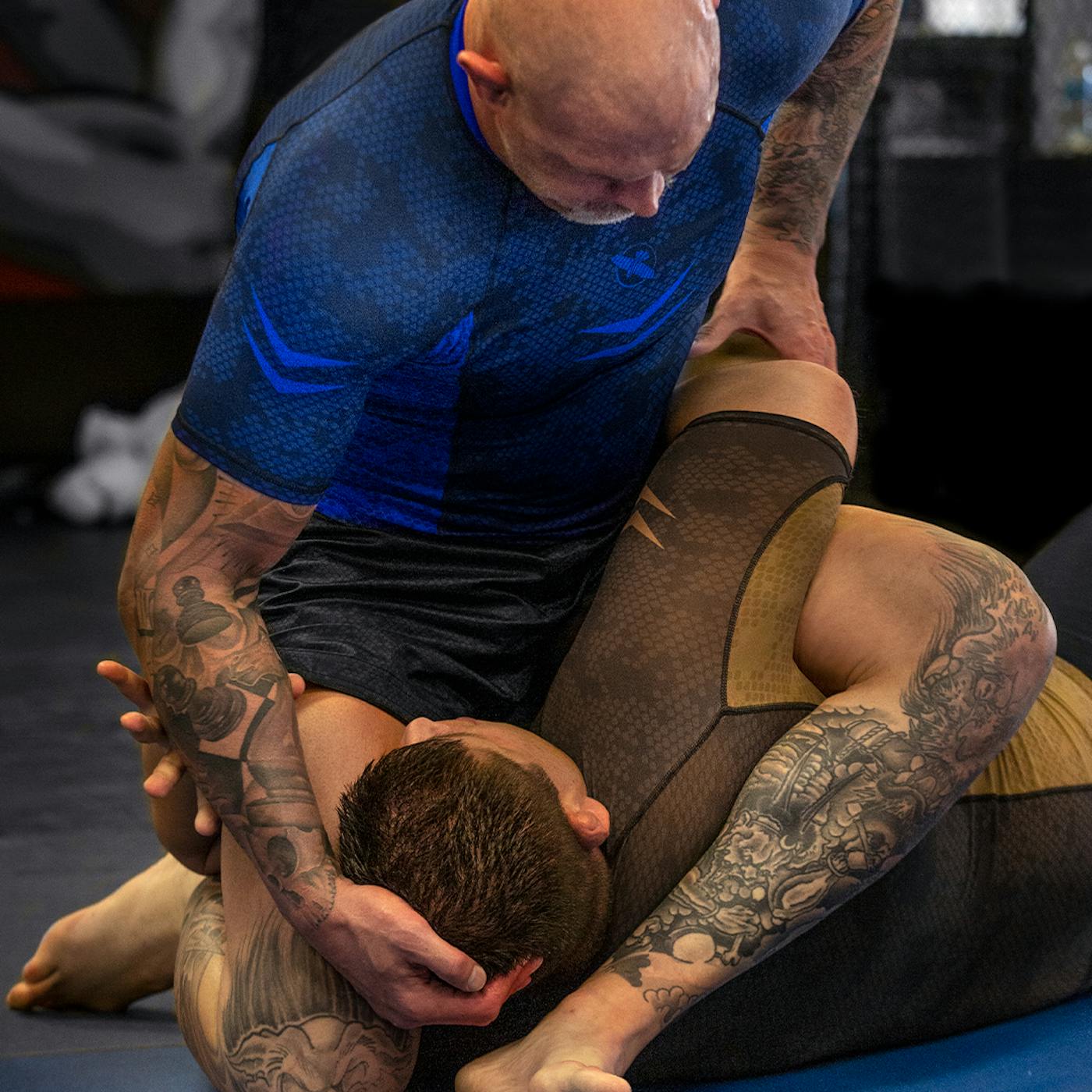Protective gear and apparel is necessary for all types of martial arts training. Whether it’s worn for boxing, MMA, Brazilian Jiu-Jitsu (BJJ), or another type of combat, protecting the body is the first priority.
In boxing, fighters wear hand wraps and boxing gloves to protect their hands, wrists, and knuckles. Whereas, in MMA and BJJ, they wear mouth guards and rash guards to protect against up-close combat and contact with the mat.
But what is a rash guard and is it always necessary to wear one? In this blog, we’ll cover the basics of BJJ rash guards, including when to wear them, and the benefits they provide. Then, you can decide how crucial they are to your training routine.
What Is a Rash Guard?
As the name suggests, rash guards are worn by BJJ competitors to protect the skin from rashes caused by friction on the mat and with opponents. BJJ involves grappling rather than maintaining space, as with boxing, so this type of combat requires another level of protection for the skin.
When to Wear a Rash Guard
Since jiu-jitsu rash guards are designed to protect the skin against chafing, irritation, and potential infection or injury, many sports recommend wearing them. Though most popularly worn during martial arts training, specifically BJJ, beach sports like volleyball and surfing often require no gi rash guards as well.
Are Rash Guards Required for Jiu-Jitsu Competitions?
Though some fighters might wear t-shirts during training, jiu-jitsu rash guards are required for competition. The International Brazilian Jiu-Jitsu Federation (IBJJF) requires rash guards for all no-gi BJJ tournaments with a length long enough to cover the no gi shorts waistband.
However, when it comes to gi competitions, the ruling differs between men and women. A men’s rash guard is not allowed per IBJJF rules, which means fighters are prohibited from wearing them under their gis.
Whereas, for women, it’s mandatory they wear a rash guard under their gis. There are a few organizations that make wearing a MMA rash guard optional, so it’s best to check with each competition’s specific rules
Benefits of BJJ Rash Guards
In addition to the instant protection BJJ rash guards provide when grappling, there are other benefits of wearing one as well.
Wicks Away Sweat
The high intensity of BJJ typically results in sweaty training sessions. This build up of sweat can cause skin irritations or infections when not absorbed or removed properly. Rash guards are designed to wick away sweat to keep the body dry.
Cools Body Temperature
As the body heats up, the increase in body temperature can make it uncomfortable, and in some cases, dangerous for a fighter. To keep the body as cool as possible, rash guards are made up of specific materials designed to reduce excess sweat and keep the body from overheating.
Creates Muscle Compression
The tight, lightweight rash guard design instantly provides support for the muscles; it slightly compresses them while still allowing the fighter to remain agile. Muscle compression is important in helping to prevent injuries during grabs, mounts, and chokeholds during a BJJ fight.
Shows Respect for Opponents
When grappling, the closeness of competitors inevitably results in sweat transfer. However, for respect of opponents, wearing a rash guard can contribute to a more hygienic fight.
Rash Guards vs. T-Shirts: Which Works Better?
When training, wearing either a rash guard or t-shirt is acceptable, though, as mentioned, this changes when it comes to competition. However, when choosing which works better, rash guards have the edge over t-shirts based on their materials and fit.
Here are a few ways they measure up:
- Rash guards are made of nylon or polyester which naturally wick away sweat and create a cooling effect. Whereas, t-shirts are made of cotton, absorbing sweat into the material and causing the potential for skin irritation or an infection.
- Rash guards provide a tight, compressive fit which protects the skin against friction with mat or grappling partner/competitor. Even the tightest t-shirt doesn’t have the same capabilities and does not provide the compressive aspect as a rash guard.
- Rash guards keep the body cool, dry, and comfortable. Whereas, t-shirts simply do not. It’s easy to notice the difference when training in a rash guard versus training in a t-shirt. The t-shirt stays wet with sweat, making it uncomfortable for the fighter and anyone they are grappling with.
- (Most) rash guards are compliant with competition regulations. The IBJJF and other organizations require specific apparel in order to compete. Everyday t-shirts do not fit the bill and are not allowed.
Marvel's The Punisher Short Sleeve Rash Guard

Marvel's The Punisher Fight Shorts

Hayabusa Fusion Long Sleeve Rash Guard

Hayabusa Geo Jiu Jitsu Spats

Are Both Rash Guards and Spats Necessary to Wear?
In general, fighters tend to wear rash guards more than spats. However, to protect the lower body, it may be beneficial to wear both.
Spats are the lower body counterpart to rash guards. They cover the legs and provide the same form-fitting comfort. For many, this type of BJJ compression wear is as important as what is worn on top.
The Best BJJ Rash Guards
There are typically two types of rash guards, short sleeve and long sleeve. However, not all rash guards are made the same. When searching for quality women and men’s compression wear, you want the material to be durable with enough stretch to conform to your mat movements.
Hayabusa Rash Guards are IBJJF-compliant and made with premium materials to support high performance and keep fighters cool and comfortable during training and competition.
Here are a few favorites from a full lineup of no gi jiu-jitsu gear:
Designed with a four-way stretch, the Fusion Short Sleeve Rash Guard fits like a second skin. The exclusive Fusion fabric shifts colors with every movement and provides a durable layer of protection for the skin.
Additionally, its sweat-wicking feature keeps the body temperature regulated. Plus, the silicone fitted waistband secures the rash guard into place so there’s no distraction when grappling. The same features make up the men’s long sleeve rash guard as well.
To cover the arms full length, the Ranked Long Sleeve Rash Guard is the ideal choice. It is IBJJF-compliant with temperature and moisture control fabric that has enough stretch to conform to the body without feeling loose.
With the ultimate in comfort and performance, the best rash guard complements a fighter’s mobility and quickness without restraint.
Hayabusa Fusion Short Sleeve Rash Guard

Hayabusa Geo Long Sleeve Rash Guard

Hayabusa Geo Short Sleeve Rash Guard

Hayabusa Ranked Long Sleeve Rash Guard

Built to endure for strenuous BJJ training, the Geo Short Sleeve Rash Guard has the same reinforced flatlock stitching and multi-way stretch fabric as the other Hayabusa rash guard designs. However, it delivers a unique geometric design symbolizing the calculated strategy needed to be a top performer.
Fight Harder with Less Friction
Hayabusa jiu-jitsu gear and apparel allows you to go full force without worrying about friction slowing you down. The best BJJ rash guards support your every move and lets you step onto the mat with confidence.
Our exclusive collections always have you covered. Check out the best BJJ gear today.











